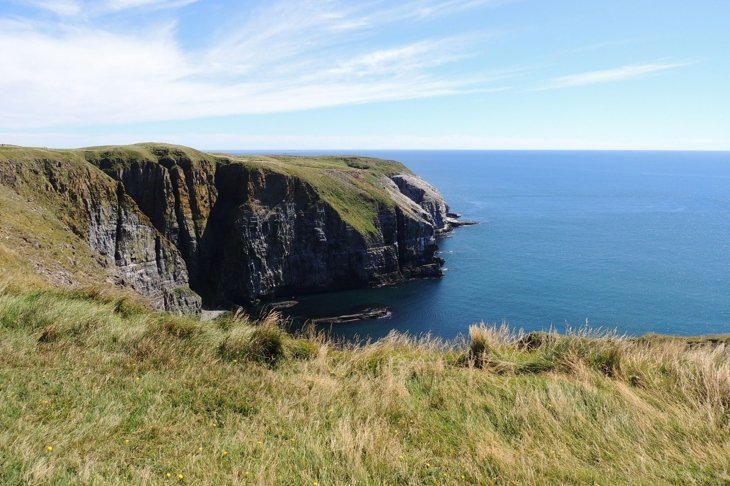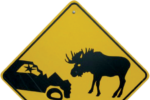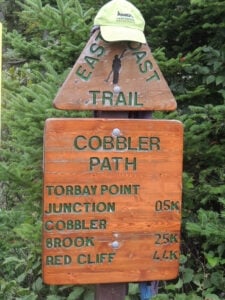
While the West Coast Trail pits the rugged beauty of coastal rainforest against brawn and bravado, the East Coast Trail, along the craggy coast of Newfoundland, has its own unpredictable challenges—and charms. Come from away, b’y, and enjoy the trek.
Just as rugged and easily as magnificent as the West Coast Trail (WCT) is the East Coast Trail (ECT) along the craggy coast of Newfoundland. But the ECT is as different from the WCT as a Vancouver hipster is from a St. John’s townie.
Someone who knows all about this is Glen Williams, a dyed-in-the-wool townie from St. John’s, Newfoundland, who married a born-and-bred Vancouverite. Now a west-coast transplant who needs a regular fix of his old Newfoundland, Glen and his wife Kathy recently hiked some of the unique routes along the ECT, a 300 km trail system that runs from Cripple Cove near Cape St. Francis at the northernmost tip of Newfoundland’s Avalon Peninsula to Cappahayden on the Southern Shore.
’Tis the rum, me son
In Quidi Vidi Village, be prepared for a screech-in (where you’ll imbibe Newfoundland rum, recite the “Newfoundland creed,” eat some Newfie steak (bologna), and kiss a cod—on the lips) or to down a microbrew at the Quidi Vidi Brewery. If your timing’s right, take in the famous Royal St. John’s Regatta on Quidi Vidi Lake: the oldest organized sporting event in North America, it draws crowds of up to 50,000 people.
Decidin’s the rub
Unlike the WCT, which is a single pathway that begins at one trailhead and ends at another, on the ECT you can start and finish just about anywhere along the trail system—a system that includes multiple trails along the total route. You can choose to trek just one path—or many.
Along the ECT, there’s a real possibility of viewing icebergs and moose on the same day as you’ve downed a pint with a local in his garage while he regales you with stories of local ghosts and pirates (“Yer from away, are ya? Set yourself down and have a beer!”).
You could start your day on Ragged Beach at Witless Bay (close to islands that are home to one of the world’s major puffin colonies), hike past Breaking Point, stooping under the tuckamore (stunted spruce trees), and continue along the windswept path to Gallows Cove Road and Mobile, south of Bay Bulls Harbour.
“Best bang fer yer buck,” according to Glen. “The Beaches Trail out of Witless Bay takes you past spectacular ocean views. There were tons of whales: a humpback put on an amazing show for us.”
Says Kathy, “Looking down from Cuckhold’s Head by The Gut [also], we watched for 30 minutes as pods of fin whales swam by, following the capelin along the shore.”
Be prepared b’y
Or you could start your day dry and warm at Aquaforte and end the day a muddy mess. The Williamses’ first day on the ECT was a revelation of sorts: the trailhead sign that read “Mudder Wet Path” was a sign of things to come.
Although the helpful guidebook describes “a peaceful walk through the woods, with views of the tidal estuary and waterfalls,” (deep) mud and (lots of) wet were predominant features—and, as Glen says: “gaiters would’ve been a good idea.”
One thing’s for sure: being prepared for just about everything is a good idea along the ECT, according to Glen, including how you get to and from your trailhead, if you’re pickin’ and choosin’ among the many options along the ECT. Driving between trailheads can be full of surprises.
Hey b’y, is that Ireland I spy?
The ECT is as far east as a trekker can go in Canada and still have feet firmly planted on terra firma. In fact, the easternmost point of land in North America is located along the ECT at Cape Spear where, as locals might tell you (with tongues firmly planted in cheeks), on a clear day, you can see Ireland.
Fact:
Facing east from Cape Spear, Ireland is, indeed, the next stop. But it’s not exactly a stone’s throw away: Dublin, Ireland, is located 3,300 km (2,050 mi/1,782 nautical miles) from Cape Spear, Newfoundland.
Hint:
 The road signs that feature pictures of moose aren’t viewpoint signs. According to Newfoundland and Labrador government estimates, the cost of vehicle damage alone is more than $1 million a year, not to mention the cost of injury to both driver and moose.
The road signs that feature pictures of moose aren’t viewpoint signs. According to Newfoundland and Labrador government estimates, the cost of vehicle damage alone is more than $1 million a year, not to mention the cost of injury to both driver and moose.
What’s the deal, b’y?
So why travel to the farthest reaches of Canada to hike? Kathy says, “If I had to summarize the appeal of the ECT, I’d say you have it to yourself—you can hike for eight hours and not see a soul. It feels very wild, and the air is fresh and clear. It’s just a really pure kind of feeling. It’s like you’re in a remote area in a rare part of the world.”
To trek the ECT is to not only view some of the most rugged geography and landscapes in the world, but to also immerse yourself in a history and culture as unique as anywhere you’ve ever visited. Where else in Canada will someone greet you with “’ow she cuttin’ dere b’y?” and send you on your way with “Long may your big jib draw”?
Newfoundland slang
Newfoundland/English dictionaries may be as scarce as hen’s teeth, so here are a few phrases you might hear along the trails of the ECT.
- “Whadda y’at b’y?” (What are you up to?)
- “Where y’ longs at?” (Where are you from?)
- “Stay where yer to ’til I comes where yer at.” (Stay where you are until I get there.)
- “Would ya take a gawk at dat!” (Would you look at that?)
Icebergs ’round these parts
While in Newfoundland, there’s a good chance you’ll spot an iceberg or two. If you’re there in the early summer, check out Iceberg Alley, where each year an average of 250 of these 10,000- to 15,000-year-old glacial giants drift along the Labrador Current onto the Grand Banks.
Great places to spot an iceberg
- Twillingate Lighthouse
- Bonavista
- John’s (Signal Hill)
- Cape Spear Lighthouse
- Bay Bulls
- Witless Bay
Sea monsters b’y?!
The legends are … well, legendary. Ask a local, and they’re bound to have a story to share about the monsters of the Newfoundland coast.
Home to the weird and wonderful, like the ocean sunfish (Mola mola) that looks like a fish head with a tail and can grow to 2,200 lb (1,000 kg), the waters off Newfoundland also host giant squid, which can grow to 43 ft (13 m) in length.
But who really knows for sure about a sea serpent (as in Scotland’s Loch Ness Monster) that locals’ll tell you is almost too strange to talk about.
You will see whales, though: up to 22 different species can be spotted off the coast of Newfoundland, including
- humpback
- minke
- pilot
- fin (finbacks)

